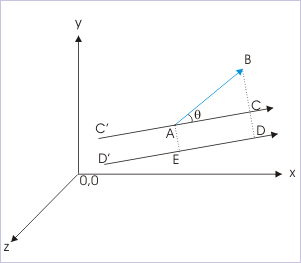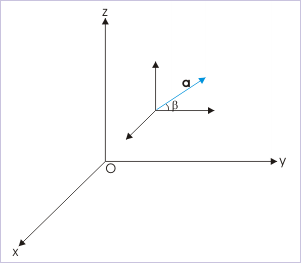| << Chapter < Page | Chapter >> Page > |
A scalar component, also known as projection, of a vector AB in the positive direction of a straight line C’C is defined as :
Where θ is the angle that vector AB makes with the specified direction C’C as shown in the figure.
Analytical method

It should be understood that the component so determined is not rooted to the common point “A” or any specific straight line like C’C in a given direction. Matter of fact, component of vector AB drawn on any straight lines like D’D parallel to CC’ are same. Note that the component i.e. projection of the vector is graphically obtained by drawing two perpendicular lines from the ends of the vector on the straight line in the specified direction.
It is clear that scalar component can either be positive or negative depending on the value of angle that the vector makes with the referred direction. The angle lies between the range given by 0 ≤ θ ≤ 180°. This interval means that we should consider the smaller angle between two vectors.
In accordance with the above definition, we resolve a given vector in three components in three mutually perpendicular directions of rectangular coordinate system. Note here that we measure angle with respect to parallel lines to the axes. By convention, we denote components by using the non-bold type face of the vector symbol with a suffix representing direction (x or y or z).
Components of a vector

Where α, β and γ are the angles that vector AB makes with the positive directions of x, y and z directions respectively.
As a vector can be resolved in a set of components, the reverse processing of components in a vector is also expected. A vector is composed from vector components in three directions along the axes of rectangular coordinate system by combining three component vectors. The vector component is the vector counterpart of the scalar component, which is obtained by multiplying the scalar component with the unit vector in axial direction. The vector components of a vector , a , are , and .
A vector, a , is equal to the vector sum of component vectors in three mutually perpendicular directions of rectangular coordinate system.
where , and are unit vectors in the respective directions.
Magnitude of the sum of two vectors ( ) in x and y direction, which are perpendicular to each other, is :
We observe here that resultant vector lies in the plane formed by the two component vectors being added. The resultant vector is, therefore, perpendicular to third component vector. Thus, the magnitude of the sum of vector ( ) and third vector , , which are perpendicular to each other, is :
Problem : Find the angle that vector 2 i + j – k makes with y-axis.
Solution : We can answer this question with the help of expression for the cosine of angle that a vector makes with a given axis. We know that component along y-axis is :
Angle

Here,
and
Hence,

Notification Switch
Would you like to follow the 'Physics for k-12' conversation and receive update notifications?